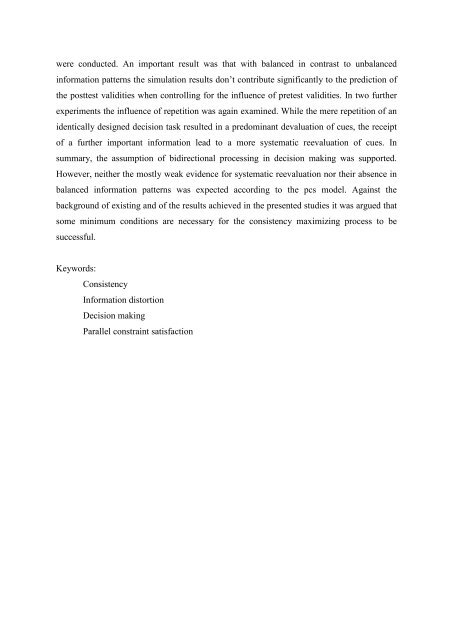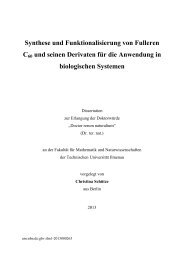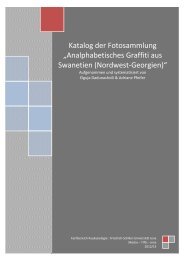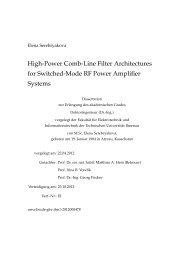- Seite 1 und 2: Das Streben nach Konsistenz im Ents
- Seite 3 und 4: Zusammenfassung Das Ziel der vorlie
- Seite 5: Abstract The aim of this thesis was
- Seite 9 und 10: INHALTSVERZEICHNIS 9 3.3 EXPERIMENT
- Seite 11 und 12: INHALTSVERZEICHNIS 11 ANHANG B: DES
- Seite 13 und 14: EINLEITUNG 13 Rumelhart, 1981; Read
- Seite 15 und 16: Konsistenz - Zentrale Charakteristi
- Seite 17 und 18: Die Erforschung der Konsistenz 17 2
- Seite 19 und 20: Die Erforschung der Konsistenz 19 w
- Seite 21 und 22: Die Erforschung der Konsistenz 21 A
- Seite 23 und 24: Die Erforschung der Konsistenz 23 E
- Seite 25 und 26: Die Erforschung der Konsistenz 25 A
- Seite 27 und 28: Die Erforschung der Konsistenz 27 E
- Seite 29 und 30: Die Erforschung der Konsistenz 29 m
- Seite 31 und 32: Die Erforschung der Konsistenz 31 Z
- Seite 33 und 34: Die Erforschung der Konsistenz 33 P
- Seite 35 und 36: Die Erforschung der Konsistenz 35 g
- Seite 37 und 38: Die Erforschung der Konsistenz 37 A
- Seite 39 und 40: Die Erforschung der Konsistenz 39 l
- Seite 41 und 42: Die Erforschung der Konsistenz 41 h
- Seite 43 und 44: Die Erforschung der Konsistenz 43 a
- Seite 45 und 46: Das Streben nach Konsistenz - Entsc
- Seite 47 und 48: Das Streben nach Konsistenz - Entsc
- Seite 49 und 50: Das Streben nach Konsistenz - Entsc
- Seite 51 und 52: Das Streben nach Konsistenz - Entsc
- Seite 53 und 54: Das Streben nach Konsistenz - Entsc
- Seite 55 und 56: Das Streben nach Konsistenz - Entsc
- Seite 57 und 58:
Das Streben nach Konsistenz - Entsc
- Seite 59 und 60:
Das Streben nach Konsistenz - Entsc
- Seite 61 und 62:
Befunde zum Streben nach Konsistenz
- Seite 63 und 64:
Befunde zum Streben nach Konsistenz
- Seite 65 und 66:
Befunde zum Streben nach Konsistenz
- Seite 67 und 68:
Befunde zum Streben nach Konsistenz
- Seite 69 und 70:
Befunde zum Streben nach Konsistenz
- Seite 71 und 72:
Befunde zum Streben nach Konsistenz
- Seite 73 und 74:
Befunde zum Streben nach Konsistenz
- Seite 75 und 76:
Befunde zum Streben nach Konsistenz
- Seite 77 und 78:
Zusammenfassung und Schlussfolgerun
- Seite 79 und 80:
Zusammenfassung und Schlussfolgerun
- Seite 81 und 82:
Zusammenfassung und Schlussfolgerun
- Seite 83 und 84:
Überblick über den empirischen Te
- Seite 85 und 86:
Methodische Vorüberlegungen 85 und
- Seite 87 und 88:
Methodische Vorüberlegungen 87 3.2
- Seite 89 und 90:
Methodische Vorüberlegungen 89 hö
- Seite 91 und 92:
Der Einfluss des Pretests 91 (Cues)
- Seite 93 und 94:
Der Einfluss des Pretests 93 men. D
- Seite 95 und 96:
Der Einfluss des Pretests 95 Validi
- Seite 97 und 98:
Der Einfluss des Pretests 97 Pretes
- Seite 99 und 100:
Der Einfluss der Wiederholung bei e
- Seite 101 und 102:
Der Einfluss der Wiederholung bei e
- Seite 103 und 104:
Der Einfluss der Wiederholung bei e
- Seite 105 und 106:
Der Einfluss des Informationsmuster
- Seite 107 und 108:
Der Einfluss des Informationsmuster
- Seite 109 und 110:
Der Einfluss des Informationsmuster
- Seite 111 und 112:
Der Einfluss des Informationsmuster
- Seite 113 und 114:
Der Einfluss des Informationsmuster
- Seite 115 und 116:
Der Einfluss des Informationsmuster
- Seite 117 und 118:
Der Einfluss des Informationsmuster
- Seite 119 und 120:
Der Einfluss des Informationsmuster
- Seite 121 und 122:
Der Einfluss des Informationsmuster
- Seite 123 und 124:
Der Einfluss des Informationsmuster
- Seite 125 und 126:
Der Einfluss des Informationsmuster
- Seite 127 und 128:
Der Einfluss des Informationsmuster
- Seite 129 und 130:
Der Einfluss des Informationsmuster
- Seite 131 und 132:
Der Einfluss des Informationsmuster
- Seite 133 und 134:
Der Einfluss des Informationsmuster
- Seite 135 und 136:
Der Einfluss des Informationsmuster
- Seite 137 und 138:
Der Einfluss des Informationsmuster
- Seite 139 und 140:
Simulationsstudien 139 ZIELSETZUNG
- Seite 141 und 142:
Simulationsstudien 141 genau diese
- Seite 143 und 144:
Simulationsstudien 143 zentrale Aus
- Seite 145 und 146:
Simulationsstudien 145 37) = 8.80,
- Seite 147 und 148:
Simulationsstudien 147 signifikante
- Seite 149 und 150:
Simulationsstudien 149 Konsistenz z
- Seite 151 und 152:
Simulationsstudien 151 ten Werte) k
- Seite 153 und 154:
Simulationsstudien 153 In keinem de
- Seite 155 und 156:
Simulationsstudien 155 METHODE Meth
- Seite 157 und 158:
Simulationsstudien 157 Tabelle 16:
- Seite 159 und 160:
Simulationsstudien 159 onsmuster zu
- Seite 161 und 162:
Der Einfluss der Wiederholung der E
- Seite 163 und 164:
Der Einfluss der Wiederholung der E
- Seite 165 und 166:
Der Einfluss der Wiederholung der E
- Seite 167 und 168:
Der Einfluss der Wiederholung der E
- Seite 169 und 170:
Der Einfluss der Wiederholung der E
- Seite 171 und 172:
Der Einfluss der Wiederholung der E
- Seite 173 und 174:
Der Einfluss der Wiederholung der E
- Seite 175 und 176:
Der Einfluss der Wiederholung der E
- Seite 177 und 178:
Der Einfluss der Wiederholung der E
- Seite 179 und 180:
Der Einfluss der Wiederholung der E
- Seite 181 und 182:
Der Einfluss der Wiederholung der E
- Seite 183 und 184:
Der Einfluss der Wiederholung der E
- Seite 185 und 186:
Der Einfluss der Wiederholung der E
- Seite 187 und 188:
Der Einfluss der Wiederholung der E
- Seite 189 und 190:
Der Einfluss der Wiederholung der E
- Seite 191 und 192:
Der Einfluss der Wiederholung der E
- Seite 193 und 194:
Der Einfluss der Wiederholung der E
- Seite 195 und 196:
Zusammenfassende Darstellung der em
- Seite 197 und 198:
Zusammenfassende Darstellung der em
- Seite 199 und 200:
Zusammenfassende Darstellung der em
- Seite 201 und 202:
Zusammenfassende Darstellung der em
- Seite 203 und 204:
Zusammenfassende Darstellung der em
- Seite 205 und 206:
Zusammenfassende Darstellung der em
- Seite 207 und 208:
Zusammenfassende Darstellung der em
- Seite 209 und 210:
Allgemeine Diskussionspunkte und of
- Seite 211 und 212:
Allgemeine Diskussionspunkte und of
- Seite 213 und 214:
Allgemeine Diskussionspunkte und of
- Seite 215 und 216:
Implikationen und Perspektiven 215
- Seite 217 und 218:
Implikationen und Perspektiven 217
- Seite 219 und 220:
Implikationen und Perspektiven 219
- Seite 221 und 222:
Implikationen und Perspektiven 221
- Seite 223 und 224:
Schlussbetrachtung 223 öffentliche
- Seite 225 und 226:
LITERATURVERZEICHNIS 225 LITERATURV
- Seite 227 und 228:
LITERATURVERZEICHNIS 227 Busemeyer,
- Seite 229 und 230:
LITERATURVERZEICHNIS 229 Fremdwört
- Seite 231 und 232:
LITERATURVERZEICHNIS 231 Hausmann,
- Seite 233 und 234:
LITERATURVERZEICHNIS 233 Kunda, Z.
- Seite 235 und 236:
LITERATURVERZEICHNIS 235 Montgomery
- Seite 237 und 238:
LITERATURVERZEICHNIS 237 Pennington
- Seite 239 und 240:
LITERATURVERZEICHNIS 239 Rumelhart,
- Seite 241 und 242:
LITERATURVERZEICHNIS 241 Svenson, O
- Seite 243 und 244:
ABBILDUNGSVERZEICHNIS 243 ABBILDUNG
- Seite 245 und 246:
TABELLENVERZEICHNIS 245 Tabelle 16:
- Seite 247 und 248:
Material und Instruktionen 247 Anha
- Seite 249 und 250:
Material und Instruktionen 249 Feri
- Seite 251 und 252:
Material und Instruktionen 251 TREA
- Seite 253 und 254:
Material und Instruktionen 253 Sehe
- Seite 255 und 256:
Material und Instruktionen 255 Ents
- Seite 257 und 258:
Material und Instruktionen 257 NACH
- Seite 259 und 260:
Material und Instruktionen 259 Trea
- Seite 261 und 262:
Material und Instruktionen 261 Oran
- Seite 263 und 264:
Material und Instruktionen 263 Anha
- Seite 265 und 266:
Material und Instruktionen 265 Die
- Seite 267 und 268:
Material und Instruktionen 267 Die
- Seite 269 und 270:
Material und Instruktionen 269 Der
- Seite 271 und 272:
Material und Instruktionen 271 12.
- Seite 273 und 274:
Material und Instruktionen 273 Pret
- Seite 275 und 276:
Material und Instruktionen 275 TREA
- Seite 277 und 278:
Material und Instruktionen 277 INST
- Seite 279 und 280:
Material und Instruktionen 279 Pret
- Seite 281 und 282:
Material und Instruktionen 281 TREA
- Seite 283 und 284:
Material und Instruktionen 283 Es i
- Seite 285 und 286:
Material und Instruktionen 285 Bedi
- Seite 287 und 288:
Deskriptiver Überblick über die V
- Seite 289 und 290:
Deskriptiver Überblick über die V
- Seite 291 und 292:
Deskriptiver Überblick über die V
- Seite 293 und 294:
Deskriptiver Überblick über die V
- Seite 295 und 296:
Weitere Ergebnisse 295 ANHANG C: WE
- Seite 297 und 298:
Weitere Ergebnisse 297 Tabelle C-3:
- Seite 299 und 300:
Weitere Ergebnisse 299 Tabelle C-5:
- Seite 301 und 302:
Weitere Ergebnisse 301 Tabelle C-7:
- Seite 303:
303 Ehrenwörtliche Erklärung Ich

















